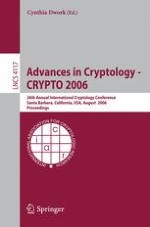2006 | Book
Advances in Cryptology - CRYPTO 2006
26th Annual International Cryptology Conference, Santa Barbara, California, USA, August 20-24, 2006. Proceedings
Editor: Cynthia Dwork
Publisher: Springer Berlin Heidelberg
Book Series : Lecture Notes in Computer Science
